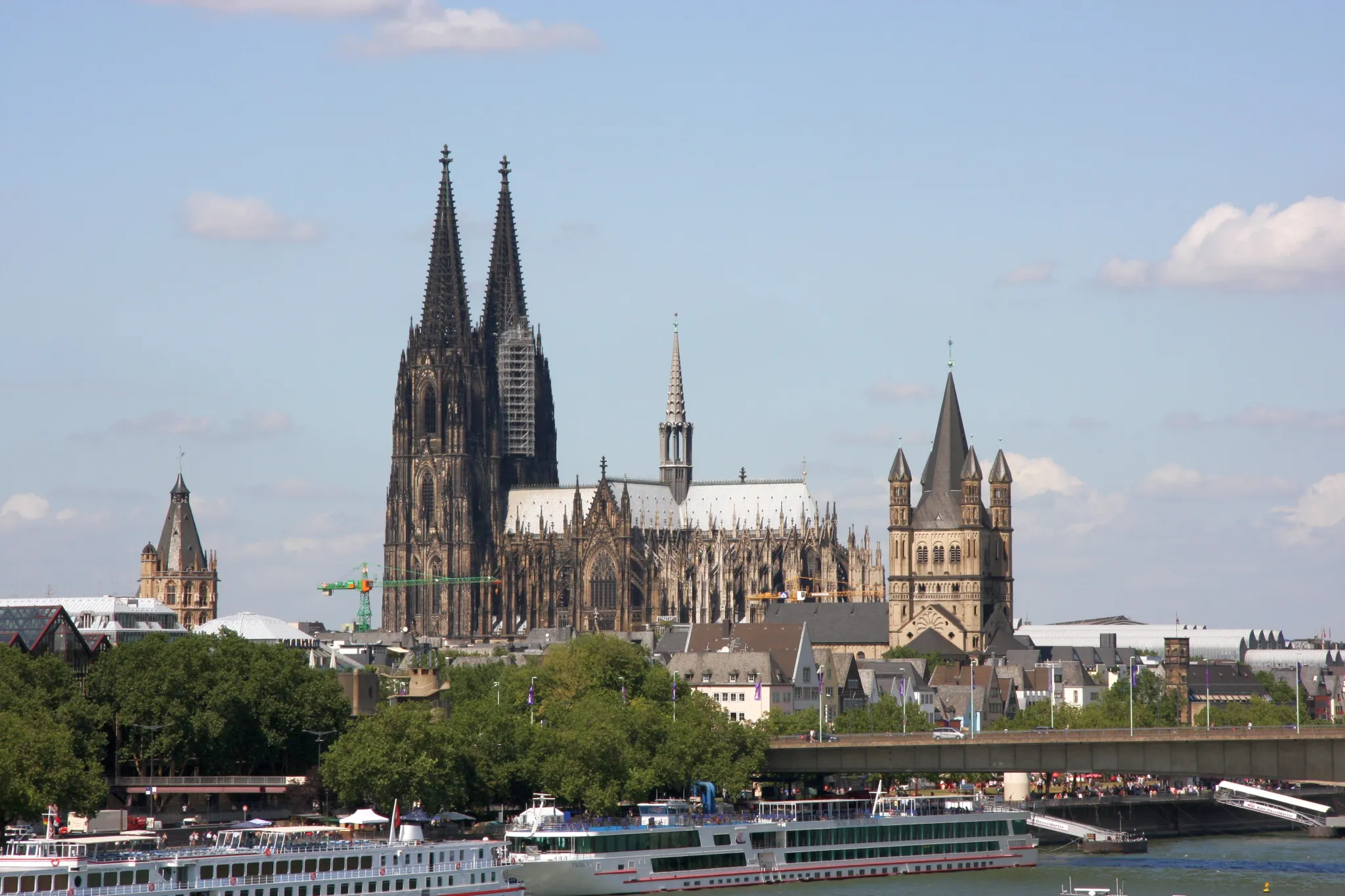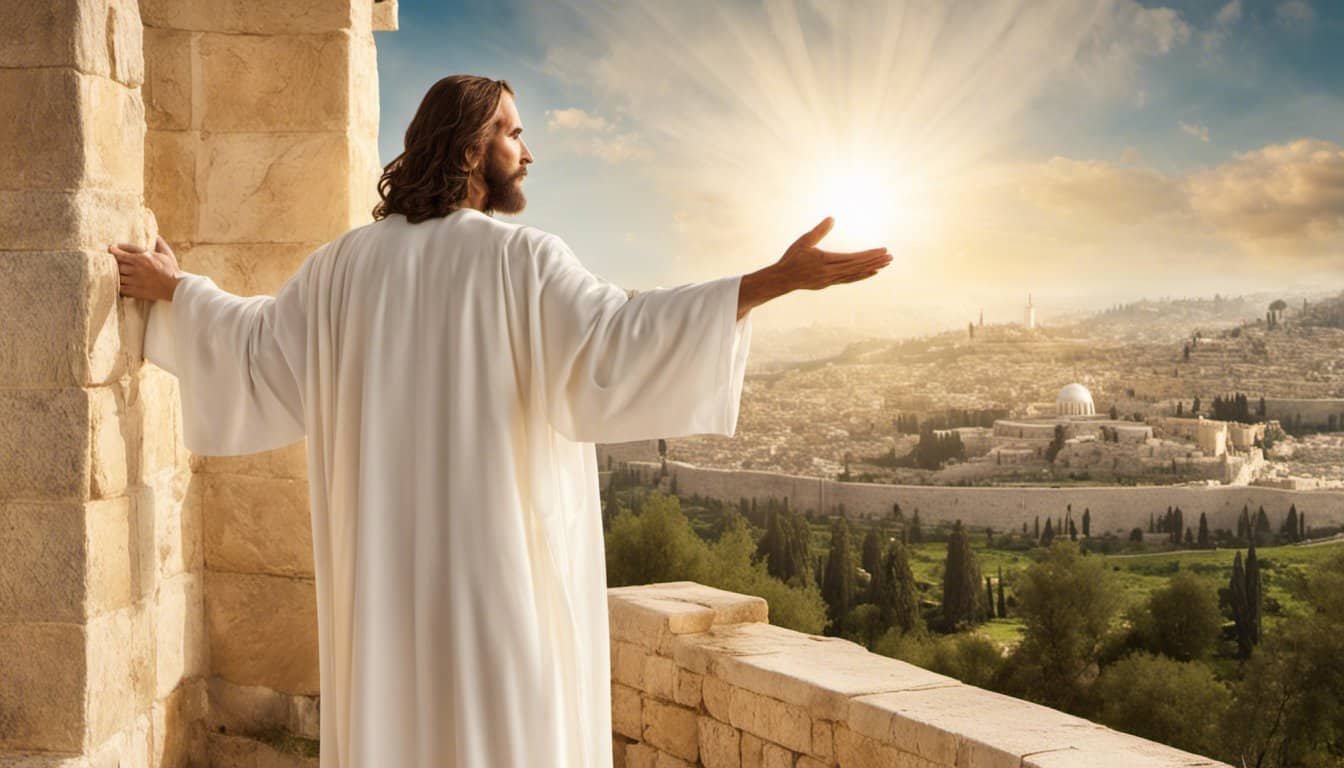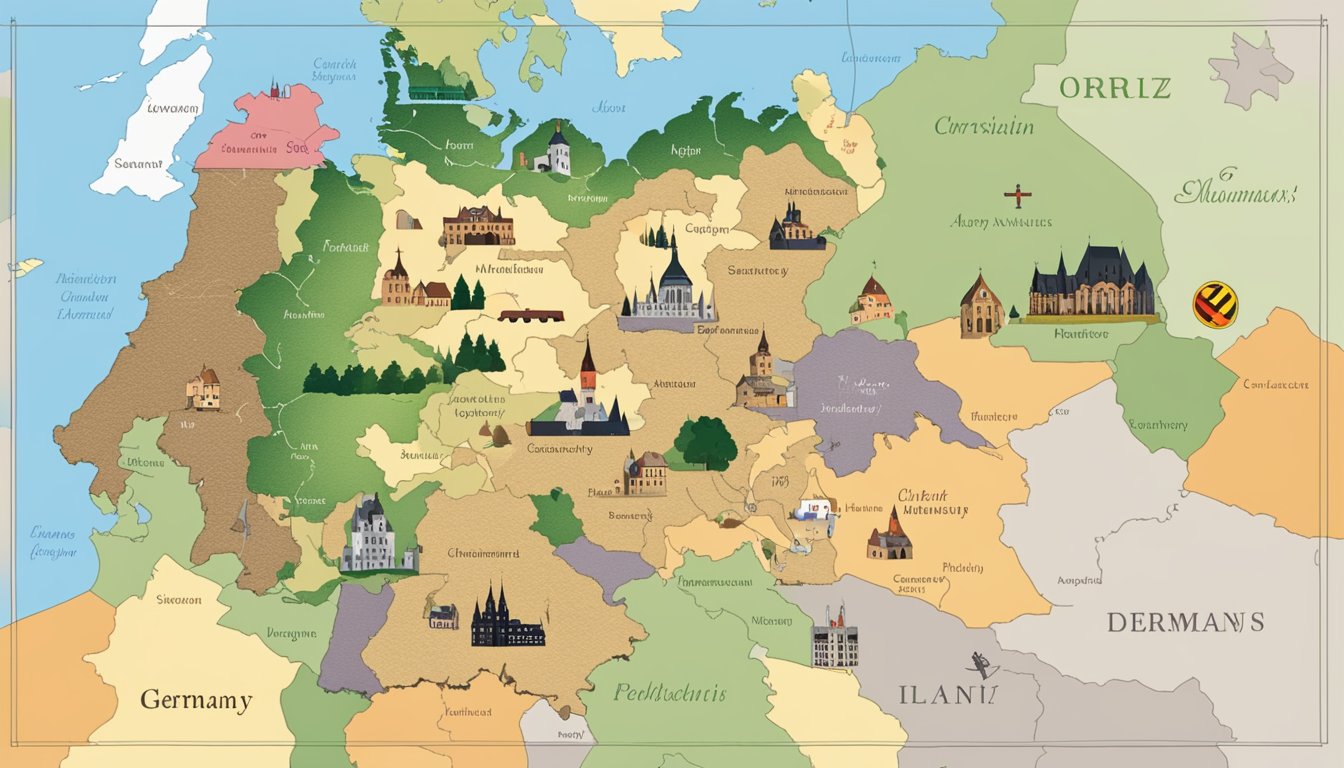Germany is a country with a rich history and culture that has had a significant impact on the world. One of the most prominent aspects of German culture is its religious heritage, particularly its Christian heritage. However, the question remains: is Germany a Christian country?

To answer this question, it is important to consider the historical context of Christianity in Germany. Christianity has been present in Germany since the Roman Empire, and it has played a significant role in shaping the country’s culture and identity. Today, Christianity remains the dominant religion in Germany, with over 50% of the population identifying as Christian.

Despite the prevalence of Christianity in Germany, the country is not officially a Christian state. Instead, Germany has a secular government that is separate from religion. However, the influence of Christianity can still be seen in various aspects of German society, including its customs, traditions, and values.
Historical Context of Christianity in Germany
https://www.youtube.com/watch?v=4YzU1r2xw8k&embed=true
Germany has a rich history of Christianity dating back to the Holy Roman Empire. This section will explore the historical context of Christianity in Germany by discussing the Holy Roman Empire, the Protestant Reformation, and the East and West Germany religious dynamics.
Holy Roman Empire
The Holy Roman Empire was a complex political entity that existed in central Europe from the 10th century to the early 19th century. The empire was ruled by a series of emperors who were crowned by the Pope in Rome. Christianity played a significant role in the Holy Roman Empire, and the Catholic Church was the dominant religious institution.
Protestant Reformation
The Protestant Reformation was a 16th-century movement that aimed to reform the Catholic Church. It was led by Martin Luther, a German monk who challenged the Church’s teachings and practices. Luther’s ideas spread quickly throughout Germany, and the Lutheran Church became the dominant Protestant denomination in the country.
East and West Germany Religious Dynamics
After World War II, Germany was divided into two separate countries: East Germany and West Germany. The religious dynamics in these two countries were very different. In East Germany, the government was officially atheist, and the Lutheran Church was heavily suppressed. In West Germany, Christianity remained a significant part of the culture, and the Catholic and Protestant Churches were both influential institutions.
In conclusion, Christianity has played a significant role in Germany’s history, from the Holy Roman Empire to the Protestant Reformation and beyond. While the religious dynamics in East and West Germany were very different, Christianity remained an important part of the country’s culture.
Demographics of Religion in Germany
https://www.youtube.com/watch?v=krqoaYwBC2c&embed=true
Germany has a population of approximately 83 million people, with Christianity being the largest religion in the country. According to Wikipedia, Christianity comprises an estimated 53.9% of the country’s population. The majority of Christians in Germany are either Protestant or Catholic, with the Protestant Church in Germany (EKD) being the largest Protestant denomination in the country. The Roman Catholic Church is the largest Christian denomination in Germany.
Christian Population
As mentioned earlier, Christianity is the largest religion in Germany, with an estimated 45.7 million Christians. The Protestant Church in Germany (EKD) has around 21.5 million members, while the Roman Catholic Church has around 23.6 million members. The Orthodox Church in Germany has around 1.6 million members, making it the third-largest Christian denomination in the country.
Religious Affiliation Trends

According to a study conducted by the Pew Research Center, the percentage of Germans who identify as Christians has been declining in recent years. In 2017, around 60% of Germans identified as Christians, while in 2009, around 70% identified as Christians. The study also found that the percentage of Germans who identify as religiously unaffiliated has been increasing, with around 37% identifying as such in 2017.
The Muslim population in Germany has also been growing in recent years. According to WorldAtlas, Islam is the largest non-Christian minority religion in Germany, with a 4.9% share of the German population adhering to Islam. There are between 3.0 and 4.7 million Muslims in Germany, with the majority of Muslims in Germany being of Turkish origin.
In conclusion, while Christianity is the largest religion in Germany, the percentage of Germans who identify as Christians has been declining in recent years. The Muslim population in Germany has been growing, and Islam is the largest non-Christian minority religion in the country.
Christian Denominations in Germany
https://www.youtube.com/watch?v=Wd2tITr9Tvg&embed=true
Germany is known for its rich Christian history and culture, but is Germany a Christian country? While Christianity plays a significant role in German culture and history, the nation has no official state religion. However, Christianity is the largest religion in Germany, with 53.9% of the population identifying as Christians in 2020 [1].
Catholic Church
The Catholic Church is the largest Christian denomination in Germany, with 26.7% of the population identifying as Catholics [1]. The Catholic Church has a long history in Germany, with the first Catholic diocese established in Trier in the 4th century. Today, the Catholic Church in Germany is organized into 27 dioceses and has approximately 23.3 million members [1].
Protestant Churches
« Is Killswitch Engage a Christian Band? Exploring the Band’s Religious Beliefs
Is Live a Christian Band? Exploring the Band’s Religious Affiliation »
Protestantism is the second-largest Christian denomination in Germany, with 27.2% of the population identifying as Protestants [1]. The Protestant Church in Germany is made up of several different denominations, including Lutheran, Calvinist, and United Protestant. The Lutheran Church is the largest Protestant denomination in Germany, with approximately 9.5 million members [1].
Orthodox Christians
Orthodox Christians represent a small but significant minority in Germany, with approximately 1.8% of the population identifying as Orthodox [1]. The Eastern Orthodox Church has a long history in Germany, dating back to the 10th century. Today, there are several Orthodox Churches in Germany, including the Russian Orthodox Church, the Greek Orthodox Church, and the Serbian Orthodox Church.
In conclusion, while Germany does not have an official state religion, Christianity is the largest religion in the country. The Catholic Church, Protestant Churches, and Orthodox Christians all have a significant presence in Germany, and each denomination has a unique history and culture that contributes to the rich tapestry of German Christianity.
[1] Christians by denomination Germany 2020 | Statista
Church and State

https://www.youtube.com/watch?v=qxt8smPwje8&embed=true
Church Tax
Germany has a unique system of church financing known as the church tax. This tax is levied on members of the Catholic and Protestant churches, and it is collected by the government. The church tax is a significant source of income for the churches in Germany, and it allows them to maintain their buildings, pay their staff, and carry out their charitable activities.
The church tax is calculated as a percentage of an individual’s income tax. The rate varies depending on the state, but it is usually between 8% and 9% of the income tax. Only members of the Catholic and Protestant churches are required to pay the church tax. If a person does not want to pay the church tax, they can formally leave the church and stop paying the tax.
Religious Education
In Germany, religious education is a mandatory subject in schools. The subject is taught by teachers who are approved by the churches. The churches have significant influence over the content of the religious education curriculum, and they are responsible for training the teachers.
Students who are not members of the Catholic or Protestant churches can choose to attend ethics classes instead of religious education. These classes cover a range of ethical and moral issues and are taught by specially trained teachers.
State Religion and Freedom

The German constitution guarantees religious freedom, and the government is prohibited from establishing a state religion. The constitution also guarantees the right to practice one’s religion freely, to form religious communities, and to teach and learn about religion.
Despite these guarantees, some critics argue that the church tax and the mandatory religious education in schools violate religious freedom. Others argue that these policies are necessary to maintain the churches’ financial stability and to ensure that students receive a comprehensive education.
Overall, the relationship between church and state in Germany is complex and multifaceted. While the government guarantees religious freedom, it also provides significant financial support to the churches and allows them to play a significant role in education.
Social Influence of Christianity
https://www.youtube.com/watch?v=OSfyYCkzLTo&embed=true
Christianity and Culture
Christianity has had a significant impact on German culture throughout history. Many famous German composers, such as Johann Sebastian Bach and Georg Friedrich Händel, were devout Christians who created music inspired by their faith. Christian themes are also prevalent in German literature, with works such as Goethe’s “Faust” and Thomas Mann’s “The Magic Mountain” exploring religious ideas.

Furthermore, Christianity has played a role in shaping German art, with many famous paintings and sculptures depicting religious scenes and figures. The influence of Christianity can also be seen in German architecture, with many churches and cathedrals being built in the Gothic style.
Churches and Social Services
Christianity has also played a significant role in providing social services in Germany. Churches have long been involved in providing healthcare and education to the community, with many hospitals and schools being founded by religious organizations.
Today, churches in Germany continue to provide a range of social services, including soup kitchens, homeless shelters, and counseling services. The German government also recognizes the important role that churches play in providing social services and provides funding to support their work.
In conclusion, Christianity has had a significant impact on German culture and society. From art and literature to social services, the influence of Christianity can be seen throughout Germany.
Interfaith Relations and Diversity
https://www.youtube.com/watch?v=Cz_qhlRN0L8&embed=true

Germany is a country that is home to people from different religious backgrounds. While the majority of Germans identify as Christian, there are also significant populations of Muslims, Jews, and other religious groups. The country has a long history of interfaith relations, and its government has taken steps to promote religious diversity and tolerance.
Islam in Germany
Islam is the largest non-Christian religion in Germany, with an estimated 3-5 million Muslims living in the country. Most of these Muslims are of Turkish origin, followed by those from countries in the former Yugoslavia, Arab countries, Iran, and Afghanistan. The Muslim population in Germany has grown significantly in recent years, and the government has taken steps to accommodate their needs.
For example, the government has recognized Islam as an official religion and has provided funding for the construction of mosques and Islamic centers. However, there have also been concerns about the integration of Muslim immigrants into German society, and there have been incidents of discrimination and prejudice against Muslims.
Judaism and Other Faiths
Jews have a long history in Germany, dating back to the Middle Ages. However, the Holocaust and the atrocities committed by the Nazis during World War II decimated the Jewish population in Germany. Today, there are estimated to be around 100,000 Jews living in Germany, and the government has taken steps to promote Jewish culture and history.
In addition to Muslims and Jews, there are also significant populations of other religious groups in Germany, including Buddhists, Hindus, and Sikhs. There are also many Germans who identify as atheist or agnostic, and the country has a strong tradition of irreligion.

Overall, Germany is a diverse country with a rich history of interfaith relations. While there have been challenges in promoting religious diversity and tolerance, the government and many Germans are committed to creating a society that is welcoming and inclusive to people of all faiths and backgrounds.
Geographical Distribution of Christians
Christianity is the largest religion in Germany, with approximately 50.7% of the population identifying themselves as Christians as of 2022 [1]. The two largest Christian churches in Germany are the Roman Catholic Church and the Evangelical Church in Germany [3].
Urban vs Rural
The distribution of Christians in Germany varies between urban and rural areas. According to a study conducted by the Bertelsmann Foundation, the percentage of Christians is higher in rural areas than in urban areas [1]. The study also found that the percentage of Christians in the eastern part of Germany is lower than in the western part of the country.
Regional Variations
There are also regional variations in the distribution of Christians in Germany. Catholicism is stronger in the southern and western parts of the country, while Protestantism is more prevalent in the northern and eastern regions [3]. Bavaria, which is located in the southern part of Germany, has the highest percentage of Catholics, with approximately 54% of the population identifying as Catholic [1]. Berlin, which is located in the northeastern region of Germany, has the lowest percentage of Christians among all the German states [3].

In conclusion, while Christianity is the largest religion in Germany, its distribution varies between urban and rural areas as well as among different regions of the country.
[1] Religion in Germany – Wikipedia
[3] The Size and Distribution of the World’s Christian Population | Pew Research Center
International Comparison
https://www.youtube.com/watch?v=u7KvvnR1UOE&embed=true
Christianity in Europe
Germany is one of the largest countries in Europe, and it has a significant Christian population. According to Deutschland.de, about half of the population identifies as Christian, with Catholics and Protestants being the two largest denominations. However, as a whole, Europe has seen a decline in Christian affiliation in recent years. In fact, a 2018 study by the Pew Research Center found that the percentage of Christians in Western Europe has dropped from 75% to 65% over the past few decades.

In terms of specific countries, some of the most Christian nations in Europe include Armenia, Greece, and England. Armenia is home to the Armenian Apostolic Church, which is one of the oldest Christian denominations in the world. Greece is predominantly Eastern Orthodox, while England is home to the Church of England, which is part of the worldwide Anglican Communion.
Global Christianity
Globally, Christianity is the largest religion, with over 2 billion followers. According to a World Population Review study, the most Christian countries in the world include the Philippines, Russia, and the Democratic Republic of Congo. Vatican City, which is the headquarters of the Catholic Church, has the highest percentage of Christians per capita.
While the Roman Catholic Church is the largest Christian denomination, there are also many other denominations, including Eastern Orthodox and Protestant. In fact, the Pew Research Center estimates that Protestants now make up less than a third of the population in Germany, while Catholics make up around 28%.
Overall, while Germany has a significant Christian population, it is not the only country in Europe or the world with a strong Christian presence. Christianity remains the largest religion globally, but its influence is declining in many parts of the world.
Contemporary Issues and Challenges
https://www.youtube.com/watch?v=UmQ-iw7qFQ0&embed=true
Secularization

Germany has been experiencing a trend of secularization in recent years. This trend refers to a decrease in the influence of religion in society and a corresponding increase in secular values and beliefs. According to a report by DW, Germany’s Christian churches are in a meltdown, with church attendance declining and the growth of atheism. This trend has affected all religious groups in Germany, including the Christian population, which is the largest in the country.
Religious Participation
Religious participation in Germany has been declining in recent years, with fewer people attending church regularly. According to DW, in 2019, there were still 45.75 million Christians in Germany, which accounted for about 52% of the population. However, the report also notes that the majority of Germans identify as Christian, be they Catholic, Protestant, Orthodox, or non-denominational. Despite this, the decline in religious participation is a significant challenge for the Christian churches in Germany, which are struggling to maintain their relevance in an increasingly secular society.
Overall, the contemporary issues and challenges facing Christianity in Germany are significant. The trend of secularization and the decline in religious participation are major challenges for the Christian churches in the country. Despite this, the Christian population remains the largest in Germany, and the role of Christianity in German art and literature continues to be significant.
Future of Christianity in Germany
https://www.youtube.com/watch?v=ne0gk6FOYZo&embed=true
Demographic Projections
According to a report by the Pew Research Center, the percentage of Christians in Germany is projected to decline from 50.7% in 2022 to 47.8% in 2050. The report also predicts that the number of people who identify as religiously unaffiliated will increase from 38.8% in 2022 to 42.6% in 2050. These projections suggest that Christianity will continue to decline in Germany, while the religiously unaffiliated population will increase.
Changing Religious Landscape
The changing religious landscape in Germany is also reflected in the attitudes of young people towards religion. A study by the Pew Forum found that only 15% of young Germans (ages 18-34) attend religious services at least once a month, compared to 47% of older Germans (ages 35 and older). This suggests that younger generations in Germany are less likely to identify as Christian or attend religious services.
Furthermore, education also plays a role in religious affiliation in Germany. The same Pew Forum study found that Germans with higher levels of education are less likely to identify as Christian. This suggests that as education levels continue to rise in Germany, the percentage of Christians may continue to decline.
Overall, the future of Christianity in Germany appears to be uncertain. While the religion has a rich history in the country, changing demographics and attitudes towards religion suggest that the percentage of Christians in Germany will continue to decline in the coming decades.
Frequently Asked Questions
What is the predominant religion practiced in Germany?
Christianity is the predominant religion in Germany, with approximately 45.7% of the population identifying as either Catholic or Protestant. While the country has a long history with Christianity, the religious landscape is changing, with a growing number of people identifying as non-religious.
How has the religious landscape in Germany changed over time?
The religious landscape in Germany has undergone significant changes over the past few decades. In the 1950s, up to 95% of the population identified as Christian. Today, that number has dropped to around 45.7%. This decline can be attributed to a growing number of people who identify as non-religious or who practice other faiths, such as Islam or Buddhism.
What are the statistics on the Muslim population in Germany as of 2023?
As of 2023, approximately 5% of the German population identifies as Muslim, making it the second-largest religious group in the country after Christianity. The Muslim population in Germany has grown significantly in recent years, largely due to immigration from Muslim-majority countries.
Is there an official state religion in Germany?
No, there is no official state religion in Germany. The country has a secular government and guarantees freedom of religion to all citizens.
Are German citizens guaranteed freedom of religion?
Yes, German citizens are guaranteed freedom of religion under the German constitution. This means that individuals are free to practice any religion they choose, and the government is prohibited from discriminating against individuals based on their religious beliefs.
Which religion is currently experiencing the fastest growth in Germany?
Islam is currently experiencing the fastest growth among religious groups in Germany. This is largely due to immigration from Muslim-majority countries, as well as a growing number of Germans converting to Islam. However, Christianity remains the largest religious group in the country.













